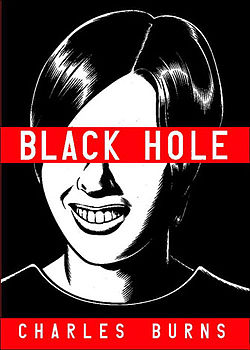 If western culture is a woman, the 60s counterculture is a tramp stamp tattooed on her ass. It was exciting at the time. As she ages, she’s regretting it more and more.
If western culture is a woman, the 60s counterculture is a tramp stamp tattooed on her ass. It was exciting at the time. As she ages, she’s regretting it more and more.
She wanted to expand her mind. She got a drug problem that exists today, dissolving America’s inner cities like psychotropic acid. She wanted an alternative to the sexual mores of Leave it to Beaver. She got a sky-high divorce rate and a generation of kids raised in dysfunctional “all you need is love” relationships. She wanted new ways of seeing the world. She got Charles Manson and Jonestown. As Peter Fonda said, “We blew it.”
Black Hole is a graphic novel about a bunch of flower power children who are going through changes. Ch-ch-changes. As they immanentize the eschaton with acoustic guitars and reefer, their bodies are starting to transform, their skin melting like congealed fat before a blowtorch.
Sometimes the physical deformities are mild, even photogenic. One girl grows a cute demonic tail. Others look like the Elephant Man. One has pustules erupting on his face like the Yellowstone supervolcano. You’d call him pizza-face, but real pizzerias are never so generous with their toppings. Some have deformities that seem to change with unknowable and perhaps eldritch patterns.
Kid after kid comes down with the “bug”. They all become social outcasts, living on the fringes and stealing from convenience stores. One thing the graphic novel hammers home: being an outcast is overrated. Yeah, disconnecting yourself from the normies sounds great and romantic. In practice, it usually just means a lonelier cage.
Charles Burns art and writing is sparse, and leaves much unsaid. Sometimes it seems like there’s unwritten pages (or perhaps unwritten novels) hiding between his panels. That too seems to evoke a period where revelation was meant to come from within.
It’s confusing and not exactly accessible, partly because of its tone and content and partly because it draws a cultural aesthetic that sunk like Atlantis. The one slight umbilicus to the present (or at least the less distant part) is the character construction. It reminds me a little of that 90s style of cartooning: think Daria, or maybe the work of Mike Diana.
Despite its difficulty, Burns has created a comic about a subject that cannot be explained: the non-religious religions and thoughtless thought-processes of the 60s. It’s an absorbing read, though a hard one. We never find out what it was that caused the deformities: my perspective is that this is something that doesn’t need to be explained. All you need to do is witness it, or at least its aftereffects. Compare and contrast with the medieval plague. Was it cats? Rats? A cesspool of sin rising to the nose of a vengeful God? None of its victims came close to understanding it. But it didn’t matter. In the end, they still died from it.
No Comments »
Comments are moderated and may take up to 24 hours to appear.
No comments yet.
